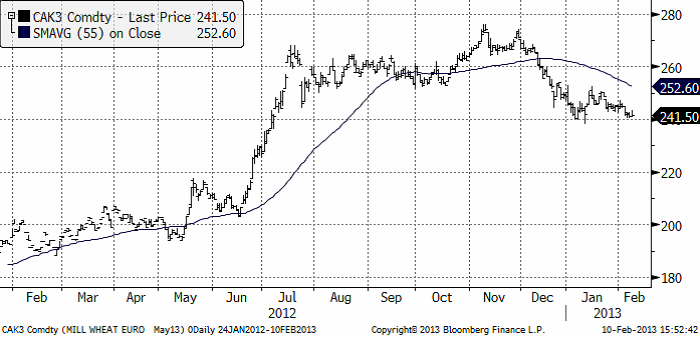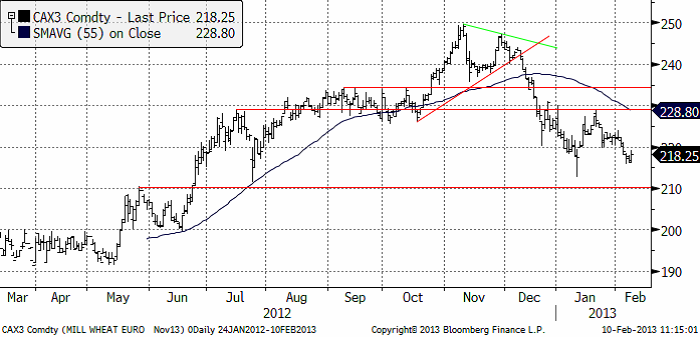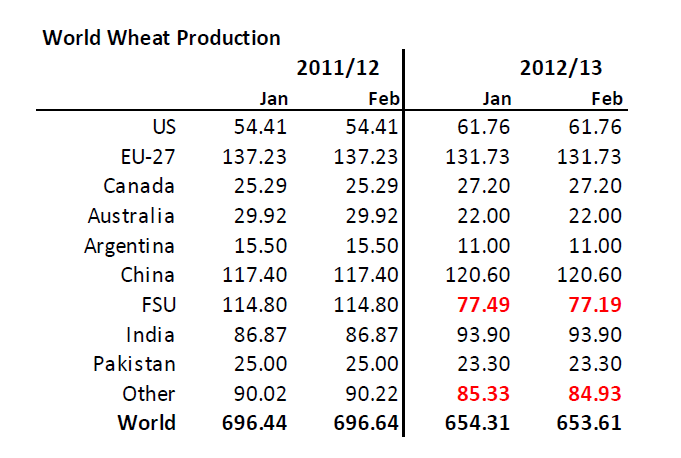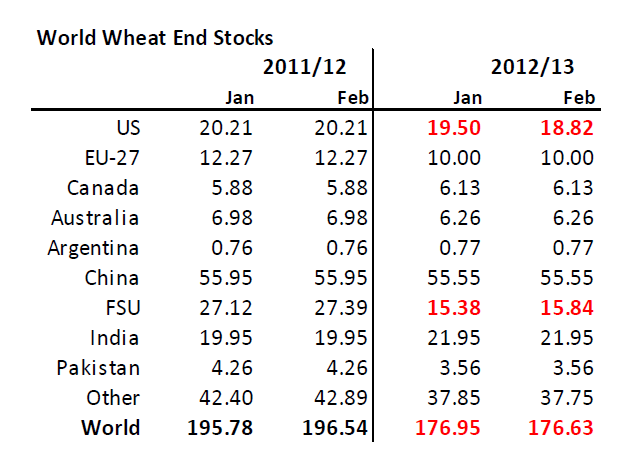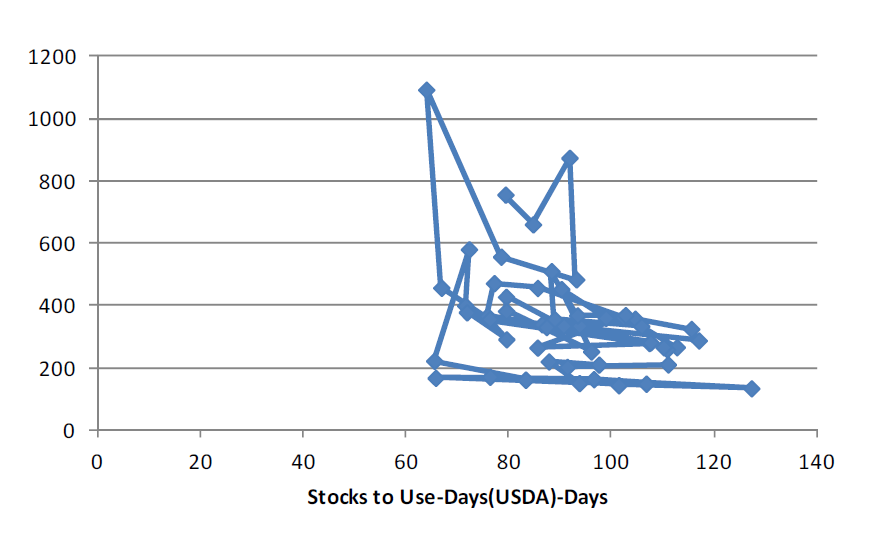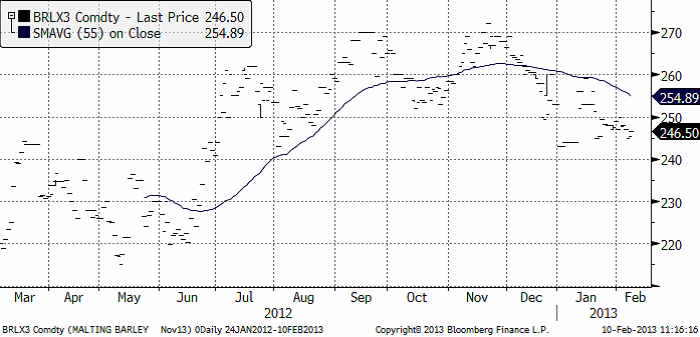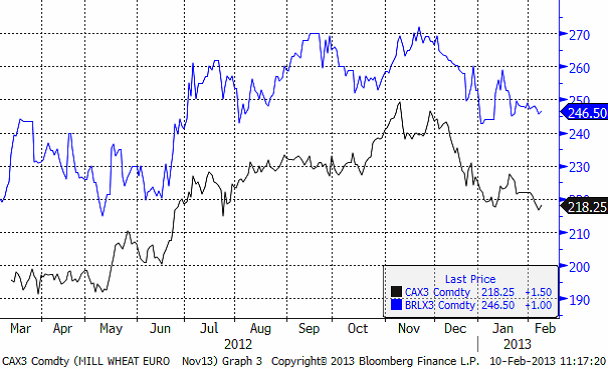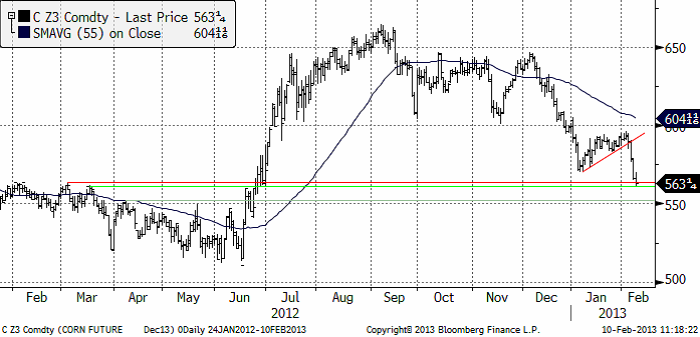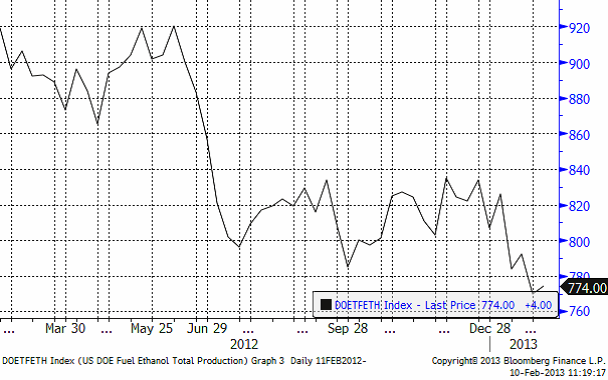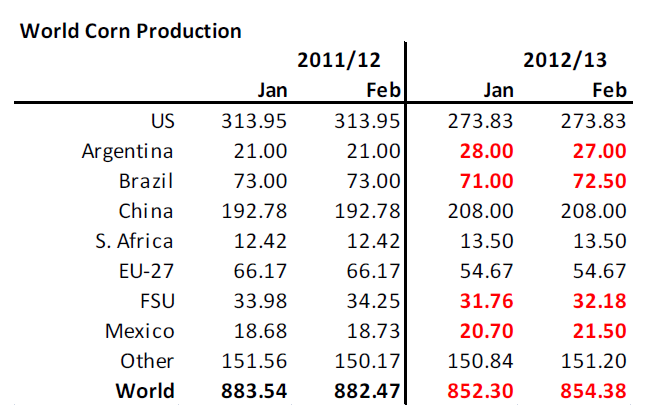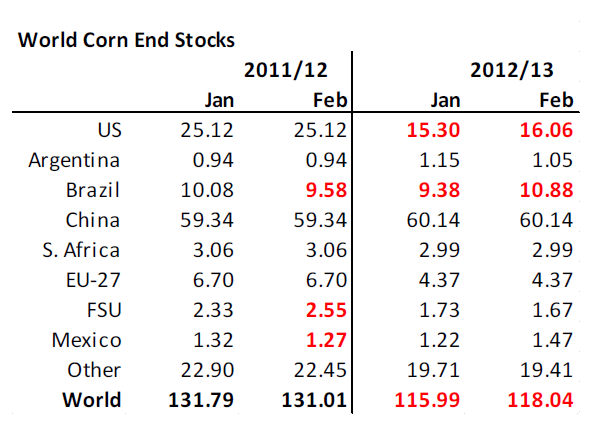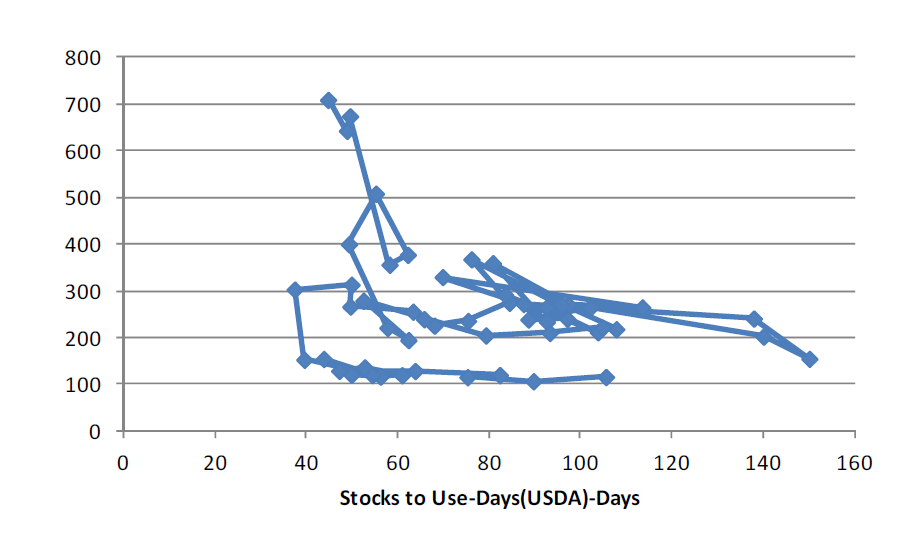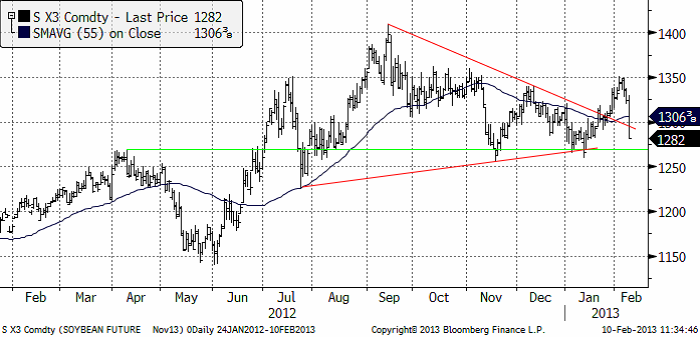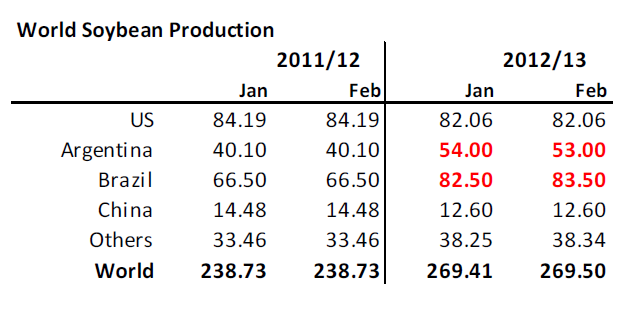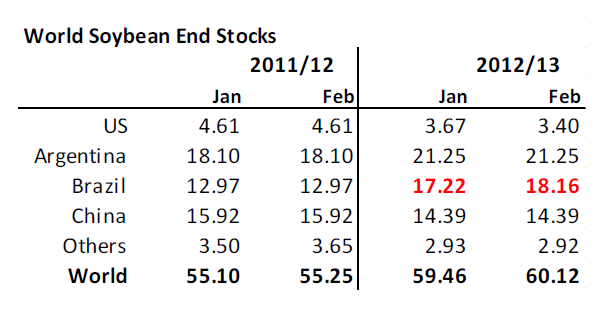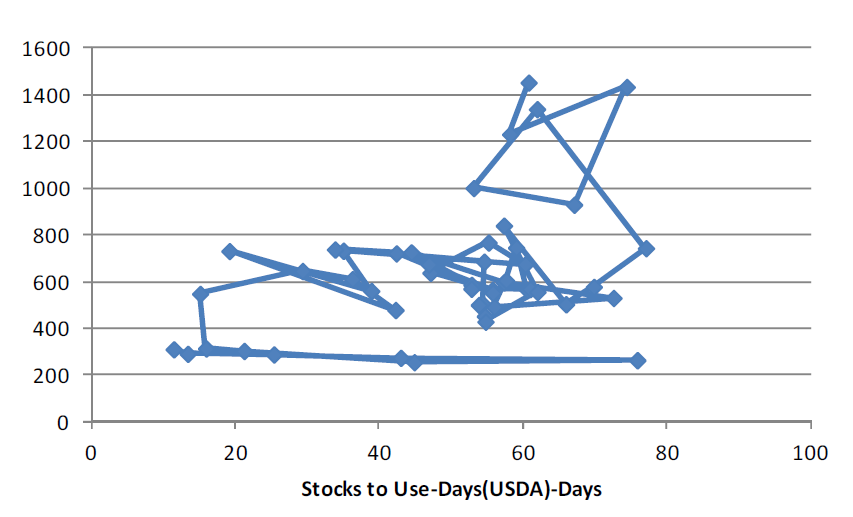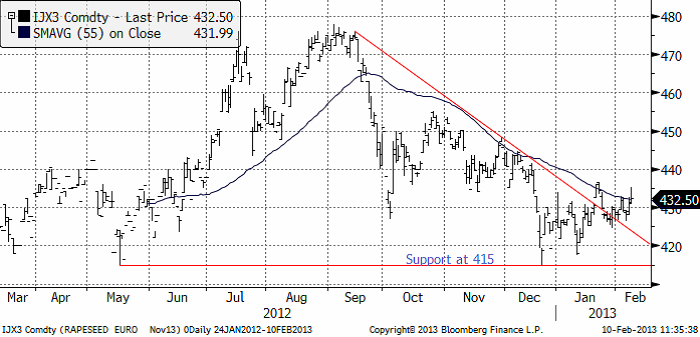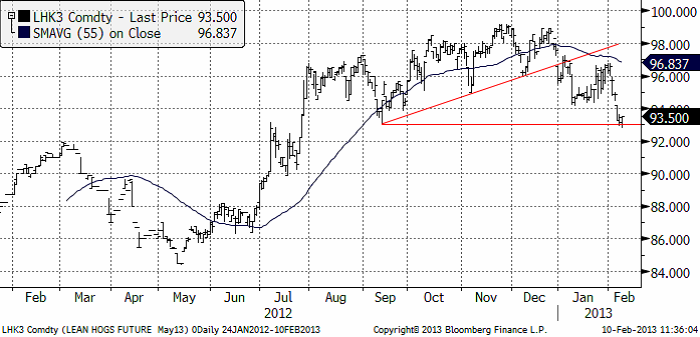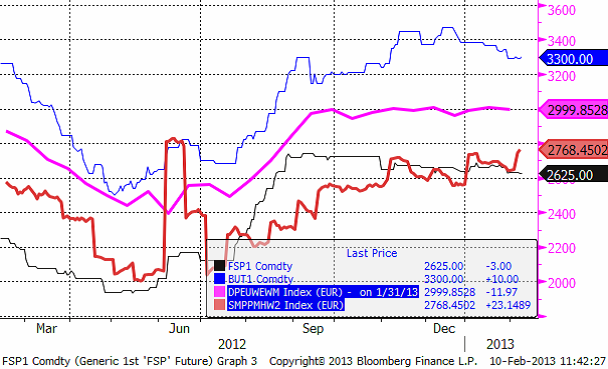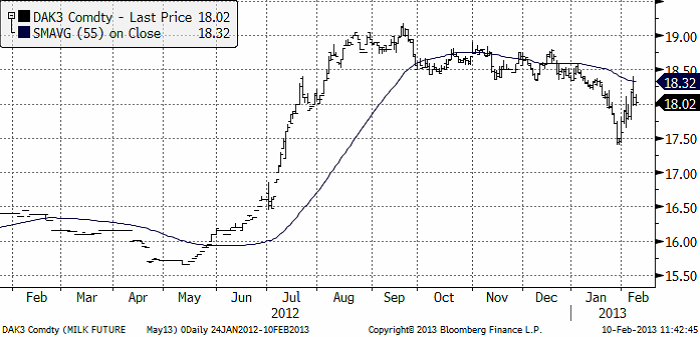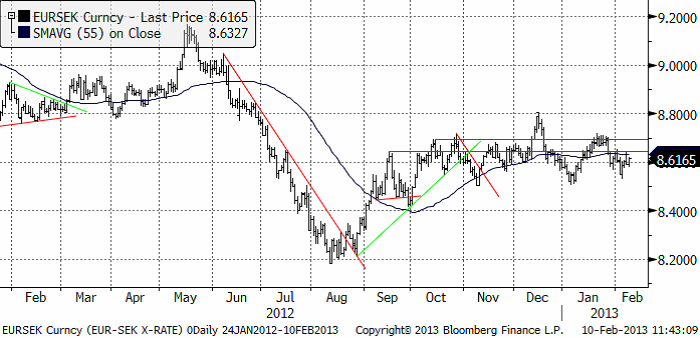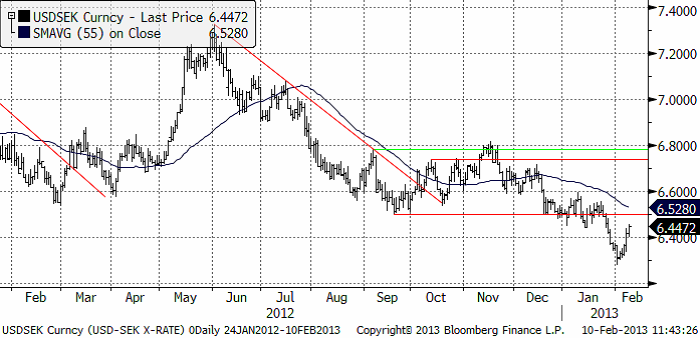Analys
SEB Jordbruksprodukter, 11 februari 2013
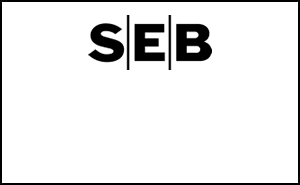
 WASDE-rapporten innehöll endast små förändringar och de förändringar som USDA gjorde var i linje med vad vi och marknaden väntat oss att de skulle göra. För vete- och majsmarknaden hände ingenting. Däremot föll priset på sojabönor ganska mycket, mer än vad som motiverades av siffrorna från USDA.
WASDE-rapporten innehöll endast små förändringar och de förändringar som USDA gjorde var i linje med vad vi och marknaden väntat oss att de skulle göra. För vete- och majsmarknaden hände ingenting. Däremot föll priset på sojabönor ganska mycket, mer än vad som motiverades av siffrorna från USDA.
Däremot visade siffrorna att det inte var så illa som några befarat. I förhållande till de senaste årens relation mellan pris och väntat utgående lager ligger priserna på vete, majs och sojabönor i linje med vad som varit ”rätt” pris.
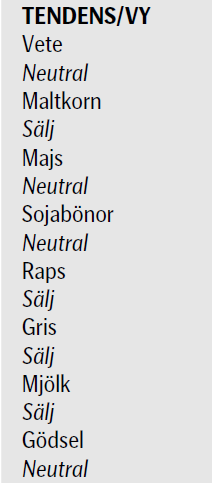 Vad gäller gammal skörd av vete förbereder sig såväl Egypten som Ryssland att försöka komma över så stor del av kakan av det lilla lager som finns i världen som möjligt. Mer om det nedan.
Vad gäller gammal skörd av vete förbereder sig såväl Egypten som Ryssland att försöka komma över så stor del av kakan av det lilla lager som finns i världen som möjligt. Mer om det nedan.
Vete
I onsdags beslöt Ryssland att ta bort importtullen om 5% på spannmål, som vi förutspådde i förra veckans veckobrev. Pådrivande kan ha varit att GASC i helgen för en vecka sedan köpte ytterligare vete, efter att just ha genomfört sin normala tender för månaden tidigare i veckan. Förra veckan skrev vi att Ryssland torde ha slut på vete mot slutet av april. Samtidigt behöver Egypten, och säkert flera andra, också köpa vete senare i vår – till rimliga priser. Det har därför varit en balansgång mellan att gå ut och köpa aggressivt till dagens höga priser å ena sidan – och att avvakta och kanske kunna få tag på vete billigare längre fram under våren. Terminskurvan indikerar lägre priser i vår – åtminstone på europeiskt vete. Eftersom lagerstatistiken och matbehovet ser ut som det gör, gissar vi på att pulsen hos marknadsaktörerna kommer att stiga ännu mer under våren.
För den som sitter på vete av gammal skörd att sälja finns all anledning att följa med. Terminspriserna visar att priset kommer att falla ordentligt när den nya skörden kommer in och avhjälper bristen. Frågan är om det går att få mer betalt för gammal skörd än dagens pris. Vi tror möjligen det. Nedan ser vi kursdiagrammet på Matif för leverans i maj:
Priset på november (2013) kontraktet har den senaste tiden fallit betydligt mer än maj-kontraktet, som vi ser i diagrammet nedan. WASDE-rapporten som kom i fredags kväll, var något av en ickehändelse. WASDE-rapporten har mer bäring på novemberkontraktet än på maj-kontraktet. De något mer bullish / oroväckande nyheterna från Ryssland och Egypten påverkar inte novemberkontraktet lika mycket som majkontraktet.
Nedan ser vi decemberkontraktet på CBOT. 800 cent bröts. 779 fungerar som ett tekniskt stöd och där ligger priset nu. Bryts det är 750 cent nästa anhalt på nedsidan.
Så nu till WASDE-rapporten. USDA:s estimat (gissningar) om produktionen för 11/12 och 12/13 ser vi nedan. Man gjorde en liten sänkning endast på fd Sovjets produktion. Brasiliens (Other) sänktes också.
Konsumtionen sänktes något för USA. Nedan ser vi estimatet för utgående lager. Det är obetydliga förändringar och rapporten innehöll inget kursdrivande alls.
Nedan ser vi relationen mellan pris och utgående lager sedan 60-talets början. Varje punkt är ett år, per den 8 februaris pris och estimerat utgående lager varje år. Vi ser att ett lager som räcker i drygt 70 dagar och ett pris på strax under 800 cent ÄR i linje med den relation som varit rådande de senaste åren. Ju mindre lager desto högre pris. Priset ser ut att ligga rätt.
Vi fortsätter vår neutrala vy på vetet.
Maltkorn
November 2013-kontraktet sjönk för tredje veckan i rad, från 247 euro per ton till 246.50.
Maltkornsmarknaden är tämligen illikvid och omsättningen har inte tagit fart, som Euronext säkert hoppats när kontraktet introducerades för några år sedan. Nedan ser vi prisutvecklingen på novemberkontraktet på maltkorn och dit för kvarnvete. Vi ser att de följer vandra åt tämligen väl. Om man skulle använda Matifs kvarnvetekontrakt för att prissäkra maltkorn blir inte följsamheten fullt så dålig som man skulle kunna tro.
Majs
Majspriset (december 2013) föll kraftigt i veckan som gick efter att ha brutit det stöd du kunde läsa om förra veckan. Priset har nu fallit ner till ett prisområde där det finns tre ganska starka tekniska stöd. Det mest sannolika härifrån är att marknaden konsoliderar sig med sidledes rörelse, eventuellt ner mot 550 cent.
Veckovis etanolproduktion i USA ökade till 704,000 fat per dag från förra veckans rekordlåga 700,000 fat.
Så till fredagens WASDE-rapport. Argentina justerades ner och Brasilien upp. Det var väntat efter det väder som varit. Ukraina och Mexiko justerades också upp något. Brasilianska CONAB förutspår dock en skörd om 76 mt och där ligger USDA efter med 72.5 mt. USDA ligger i och för sig också efter vad man kan tro om ännu lägre skörd i Argentina. På global basis, som vi ser nedan, en något högre väntad skörd i år.
Utgående lager höjdes tillräckligt i rapporten för att ge säljarna ytterligare vind i seglen. Men det är kommer fortfarande att bli ont om majs i sommar, innan den nya skörden kommer in.
Nedan ser vi relationen mellan lager och pris. Liksom för vetet visar diagrammet förhållandet mellan lager och pris varje år i februari.
Även fast lagren är så små att det inte finns så många punkter med lägre lager att förlita sig på, förefaller inte priset nu avvika allt för mycket från de senaste årens relation mellan lager och pris. Vi fortsätter att ha en neutral vy på majs.
Sojabönor
Sojabönorna (november 2013) föll kraftigt efter WASDE-rapporten i fredags. Nästan ända ner till de tekniska stöden vid 1260 cent per bushel. Nedanför ser vi kurdiagrammet för sojabönor (november 2013).
WASDE-rapportens produktionsestimat handlade helt om Sydamerika. Argentinas väntade skörd justerades ner 1 mt och Brasiliens upp lika mycket. Resten lämnades oförändrat.
Nedan ser vi USDA:s estimat på utgående lager. Det är inte någon kioskvältare på papperet. En höjning med lite drygt 0.5 mt. Lagren i USA sänktes till 3.40 från 3.67 mt. Utgående lager i Brasilien höjdes.
Nedan ser vi relationen mellan pris och lager. I förhållande till de senaste årens relation, ser låg priset innan rapporten något högt. Efter fredagens prisfall ligger priset mer eller mindre mitt i linje med den historiska relationen.
Vi fortsätter därför att ha en neutral rekommendation på sojabönorna.
Raps
Rapspriset (november 2013) har utvecklat sig starkare än sojabönorna. Ett försök att handla rapsen högre i veckan hindrades dock av WASDE-rapporten och det betydande prisfallet efter den i sojabönsmarknaden.
Vi ligger kvar med vår negativa vy för rapspriset.
Gris
Grispriset (Maj 13) föll förra veckan ner till 93.50. Läsare av veckobrevet har tidigare kunnat läsa att rekylen uppåt efter brottet av den tekniska stödnivån skulle tolkas som ett tillfälle att sälja. Det visade sig vara rätt. Nu ligger priset på stödet och därifrån får marknaden visa vägen. Ännu ett brott nedåt innebär att prisfallet kan fortsätta.
Mjölk
Fonterras auktion i onsdags visade på en prisuppgång på SMP. På Eurex fortsatte dock kräftgången i SMP. Prisutvecklingen på smör fortsatte att falla tillbaka efter toppen i december. I diagrammet nedan ser vi nu fyra kurvor. Den övre tunna linjen är EUREX SMP. Den nedre tunna linjen är Eurex SMP. Den rosa linjen visar priset på helmjölkspulver (WMP) FOB Västeuropa. Källan är USDA och priserna uppdateras varannan vecka. Den röda linjen är Fonterras auktion.
Beprövad erfarenhet säger att vi ska vänta oss ett nytt kraftigt prisfall inom kort.
EURSEK
EURSEK fortsatte att röra sig sidledes i veckan som gick. Utsikterna för den kommande veckan är att detta kommer att fortsätta.
USDSEK
Dollarn rekylerade uppåt mot slutet av veckan. Detta ser ut knappast ut som ett trendbrott, utan som en rekyl i en fallande trend. Därmed är det ett säljtillfälle.
[box]SEB Veckobrev Jordbruksprodukter är producerat av SEB Merchant Banking och publiceras i samarbete och med tillstånd på Råvarumarknaden.se[/box]
Disclaimer
The information in this document has been compiled by SEB Merchant Banking, a division within Skandinaviska Enskilda Banken AB (publ) (“SEB”).
Opinions contained in this report represent the bank’s present opinion only and are subject to change without notice. All information contained in this report has been compiled in good faith from sources believed to be reliable. However, no representation or warranty, expressed or implied, is made with respect to the completeness or accuracy of its contents and the information is not to be relied upon as authoritative. Anyone considering taking actions based upon the content of this document is urged to base his or her investment decisions upon such investigations as he or she deems necessary. This document is being provided as information only, and no specific actions are being solicited as a result of it; to the extent permitted by law, no liability whatsoever is accepted for any direct or consequential loss arising from use of this document or its contents.
About SEB
SEB is a public company incorporated in Stockholm, Sweden, with limited liability. It is a participant at major Nordic and other European Regulated Markets and Multilateral Trading Facilities (as well as some non-European equivalent markets) for trading in financial instruments, such as markets operated by NASDAQ OMX, NYSE Euronext, London Stock Exchange, Deutsche Börse, Swiss Exchanges, Turquoise and Chi-X. SEB is authorized and regulated by Finansinspektionen in Sweden; it is authorized and subject to limited regulation by the Financial Services Authority for the conduct of designated investment business in the UK, and is subject to the provisions of relevant regulators in all other jurisdictions where SEB conducts operations. SEB Merchant Banking. All rights reserved.
Analys
More weakness and lower price levels ahead, but the world won’t drown in oil in 2026

Some rebound but not much. Brent crude rebounded 1.5% yesterday to $65.47/b. This morning it is inching 0.2% up to $65.6/b. The lowest close last week was on Thursday at $64.11/b.

The curve structure is almost as week as it was before the weekend. The rebound we now have gotten post the message from OPEC+ over the weekend is to a large degree a rebound along the curve rather than much strengthening at the front-end of the curve. That part of the curve structure is almost as weak as it was last Thursday.
We are still on a weakening path. The message from OPEC+ over the weekend was we are still on a weakening path with rising supply from the group. It is just not as rapidly weakening as was feared ahead of the weekend when a quota hike of 500 kb/d/mth for November was discussed.
The Brent curve is on its way to full contango with Brent dipping into the $50ies/b. Thus the ongoing weakening we have had in the crude curve since the start of the year, and especially since early June, will continue until the Brent crude oil forward curve is in full contango along with visibly rising US and OECD oil inventories. The front-month Brent contract will then flip down towards the $60/b-line and below into the $50ies/b.
At what point will OPEC+ turn to cuts? The big question then becomes: When will OPEC+ turn around to make some cuts? At what (price) point will they choose to stabilize the market? Because for sure they will. Higher oil inventories, some more shedding of drilling rigs in US shale and Brent into the 50ies somewhere is probably where the group will step in.
There is nothing we have seen from the group so far which indicates that they will close their eyes, let the world drown in oil and the oil price crash to $40/b or below.
The message from OPEC+ is also about balance and stability. The world won’t drown in oil in 2026. The message from the group as far as we manage to interpret it is twofold: 1) Taking back market share which requires a lower price for non-OPEC+ to back off a bit, and 2) Oil market stability and balance. It is not just about 1. Thus fretting about how we are all going to drown in oil in 2026 is totally off the mark by just focusing on point 1.
When to buy cal 2026? Before Christmas when Brent hits $55/b and before OPEC+ holds its last meeting of the year which is likely to be in early December.
Brent crude oil prices have rebounded a bit along the forward curve. Not much strengthening in the structure of the curve. The front-end backwardation is not much stronger today than on its weakest level so far this year which was on Thursday last week.

The front-end backwardation fell to its weakest level so far this year on Thursday last week. A slight pickup yesterday and today, but still very close to the weakest year to date. More oil from OPEC+ in the coming months and softer demand and rising inventories. We are heading for yet softer levels.

Analys
A sharp weakening at the core of the oil market: The Dubai curve

Down to the lowest since early May. Brent crude has fallen sharply the latest four days. It closed at USD 64.11/b yesterday which is the lowest since early May. It is staging a 1.3% rebound this morning along with gains in both equities and industrial metals with an added touch of support from a softer USD on top.

What stands out the most to us this week is the collapse in the Dubai one to three months time-spread.
Dubai is medium sour crude. OPEC+ is in general medium sour crude production. Asian refineries are predominantly designed to process medium sour crude. So Dubai is the real measure of the balance between OPEC+ holding back or not versus Asian oil demand for consumption and stock building.
A sharp weakening of the front-end of the Dubai curve. The front-end of the Dubai crude curve has been holding out very solidly throughout this summer while the front-end of the Brent and WTI curves have been steadily softening. But the strength in the Dubai curve in our view was carrying the crude oil market in general. A source of strength in the crude oil market. The core of the strength.
The now finally sharp decline of the front-end of the Dubai crude curve is thus a strong shift. Weakness in the Dubai crude marker is weakness in the core of the oil market. The core which has helped to hold the oil market elevated.
Facts supports the weakening. Add in facts of Iraq lifting production from Kurdistan through Turkey. Saudi Arabia lifting production to 10 mb/d in September (normal production level) and lifting exports as well as domestic demand for oil for power for air con is fading along with summer heat. Add also in counter seasonal rise in US crude and product stocks last week. US oil stocks usually decline by 1.3 mb/week this time of year. Last week they instead rose 6.4 mb/week (+7.2 mb if including SPR). Total US commercial oil stocks are now only 2.1 mb below the 2015-19 seasonal average. US oil stocks normally decline from now to Christmas. If they instead continue to rise, then it will be strongly counter seasonal rise and will create a very strong bearish pressure on oil prices.
Will OPEC+ lift its voluntary quotas by zero, 137 kb/d, 500 kb/d or 1.5 mb/d? On Sunday of course OPEC+ will decide on how much to unwind of the remaining 1.5 mb/d of voluntary quotas for November. Will it be 137 kb/d yet again as for October? Will it be 500 kb/d as was talked about earlier this week? Or will it be a full unwind in one go of 1.5 mb/d? We think most likely now it will be at least 500 kb/d and possibly a full unwind. We discussed this in a not earlier this week: ”500 kb/d of voluntary quotas in October. But a full unwind of 1.5 mb/d”
The strength in the front-end of the Dubai curve held out through summer while Brent and WTI curve structures weakened steadily. That core strength helped to keep flat crude oil prices elevated close to the 70-line. Now also the Dubai curve has given in.

Brent crude oil forward curves

Total US commercial stocks now close to normal. Counter seasonal rise last week. Rest of year?

Total US crude and product stocks on a steady trend higher.

Analys
OPEC+ will likely unwind 500 kb/d of voluntary quotas in October. But a full unwind of 1.5 mb/d in one go could be in the cards

Down to mid-60ies as Iraq lifts production while Saudi may be tired of voluntary cut frugality. The Brent December contract dropped 1.6% yesterday to USD 66.03/b. This morning it is down another 0.3% to USD 65.8/b. The drop in the price came on the back of the combined news that Iraq has resumed 190 kb/d of production in Kurdistan with exports through Turkey while OPEC+ delegates send signals that the group will unwind the remaining 1.65 mb/d (less the 137 kb/d in October) of voluntary cuts at a pace of 500 kb/d per month pace.

Signals of accelerated unwind and Iraqi increase may be connected. Russia, Kazakhstan and Iraq were main offenders versus the voluntary quotas they had agreed to follow. Russia had a production ’debt’ (cumulative overproduction versus quota) of close to 90 mb in March this year while Kazakhstan had a ’debt’ of about 60 mb and the same for Iraq. This apparently made Saudi Arabia angry this spring. Why should Saudi Arabia hold back if the other voluntary cutters were just freeriding? Thus the sudden rapid unwinding of voluntary cuts. That is at least one angle of explanations for the accelerated unwinding.
If the offenders with production debts then refrained from lifting production as the voluntary cuts were rapidly unwinded, then they could ’pay back’ their ’debts’ as they would under-produce versus the new and steadily higher quotas.
Forget about Kazakhstan. Its production was just too far above the quotas with no hope that the country would hold back production due to cross-ownership of oil assets by international oil companies. But Russia and Iraq should be able to do it.
Iraqi cumulative overproduction versus quotas could reach 85-90 mb in October. Iraq has however steadily continued to overproduce by 3-5 mb per month. In July its new and gradually higher quota came close to equal with a cumulative overproduction of only 0.6 mb that month. In August again however its production had an overshoot of 100 kb/d or 3.1 mb for the month. Its cumulative production debt had then risen to close to 80 mb. We don’t know for September yet. But looking at October we now know that its production will likely average close to 4.5 mb/d due to the revival of 190 kb/d of production in Kurdistan. Its quota however will only be 4.24 mb/d. Its overproduction in October will thus likely be around 250 kb/d above its quota with its production debt rising another 7-8 mb to a total of close to 90 mb.
Again, why should Saudi Arabia be frugal while Iraq is freeriding. Better to get rid of the voluntary quotas as quickly as possible and then start all over with clean sheets.
Unwinding the remaining 1.513 mb/d in one go in October? If OPEC+ unwinds the remaining 1.513 mb/d of voluntary cuts in one big go in October, then Iraq’s quota will be around 4.4 mb/d for October versus its likely production of close to 4.5 mb/d for the coming month..
OPEC+ should thus unwind the remaining 1.513 mb/d (1.65 – 0.137 mb/d) in one go for October in order for the quota of Iraq to be able to keep track with Iraq’s actual production increase.
October 5 will show how it plays out. But a quota unwind of at least 500 kb/d for Oct seems likely. An overall increase of at least 500 kb/d in the voluntary quota for October looks likely. But it could be the whole 1.513 mb/d in one go. If the increase in the quota is ’only’ 500 kb/d then Iraqi cumulative production will still rise by 5.7 mb to a total of 85 mb in October.
Iraqi production debt versus quotas will likely rise by 5.7 mb in October if OPEC+ only lifts the overall quota by 500 kb/d in October. Here assuming historical production debt did not rise in September. That Iraq lifts its production by 190 kb/d in October to 4.47 mb/d (August level + 190 kb/d) and that OPEC+ unwinds 500 kb/d of the remining quotas in October when they decide on this on 5 October.

-

 Nyheter4 veckor sedan
Nyheter4 veckor sedanMahvie Minerals i en guldtrend
-

 Analys4 veckor sedan
Analys4 veckor sedanVolatile but going nowhere. Brent crude circles USD 66 as market weighs surplus vs risk
-

 Nyheter4 veckor sedan
Nyheter4 veckor sedanAktier i guldbolag laggar priset på guld
-

 Nyheter3 veckor sedan
Nyheter3 veckor sedanKinas elproduktion slog nytt rekord i augusti, vilket även kolkraft gjorde
-

 Nyheter3 veckor sedan
Nyheter3 veckor sedanTyskland har så höga elpriser att företag inte har råd att använda elektricitet
-

 Nyheter4 veckor sedan
Nyheter4 veckor sedanGuld når sin högsta nivå någonsin, nu även justerat för inflation
-

 Nyheter4 veckor sedan
Nyheter4 veckor sedanDet stigande guldpriset en utmaning för smyckesköpare
-

 Analys4 veckor sedan
Analys4 veckor sedanWaiting for the surplus while we worry about Israel and Qatar


